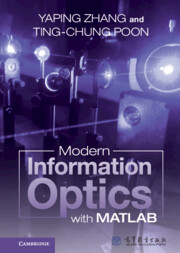Book contents
- Frontmatter
- Dedication
- Contents
- Preface
- 1 Gaussian Optics and Uncertainty Principle
- 2 Linear Invariant Systems and Fourier Analysis
- 3 Wave Propagation and Wave Optics
- 4 Spatial Coherent and Incoherent Optical Systems
- 5 Principles of Coherent Holography
- 6 Digital Holography
- 7 Spatial Light Modulators for Processing Optical Information
- Index
- References
6 - Digital Holography
Published online by Cambridge University Press: 22 December 2022
- Frontmatter
- Dedication
- Contents
- Preface
- 1 Gaussian Optics and Uncertainty Principle
- 2 Linear Invariant Systems and Fourier Analysis
- 3 Wave Propagation and Wave Optics
- 4 Spatial Coherent and Incoherent Optical Systems
- 5 Principles of Coherent Holography
- 6 Digital Holography
- 7 Spatial Light Modulators for Processing Optical Information
- Index
- References
Summary
Film-based holography employs the use of high-resolution films such as the use of photopolymers or photorefractive materials for recording. These materials, while having high resolution, have a couple of drawbacks. The film-based techniques are typically slow for real-time applications and difficult to allow direct access to the recorded hologram for manipulation and subsequent processing. With recent advances in high-resolution solid-state 2-D sensors and the availability of ever-increasing power of computers and digital data storage capabilities, holography coupled with electronic/digital devices has become an emerging technology with an increasing number of applications such as in metrology, nondestructive testing, and 3-D imaging. While electronic detection of holograms by a TV camera was first performed by Enloe et al. in 1966, hologram numerical reconstruction was initiated by Goodman and Lawrence. In digital holography, it has meant that holographic information of 3-D objects is captured by a CCD, and reconstruction of holograms is subsequently calculated numerically. Nowadays, digital holography means the following situations as well. Holographic recording is done by an electronic device, and the recorded hologram can be numerically reconstructed or sent to a display device (called a spatial light modulator) for optical reconstruction. Or, hologram construction is completely numerically simulated. The resulting hologram is sent subsequently to a display device for optical reconstruction. This aspect of digital holography is often known as computer-generated holography.
Keywords
- Type
- Chapter
- Information
- Modern Information Optics with MATLAB , pp. 190 - 259Publisher: Cambridge University PressPrint publication year: 2023



